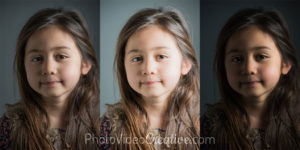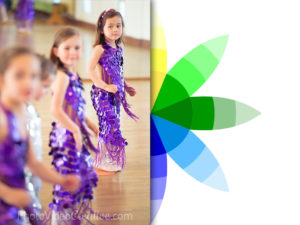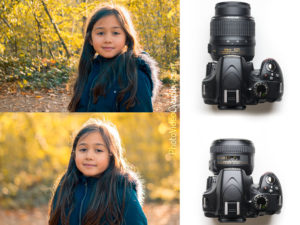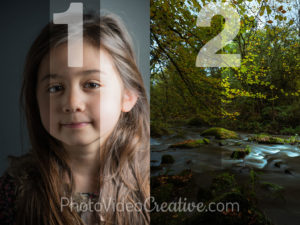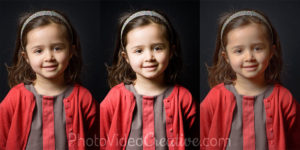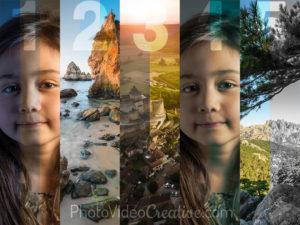A smartphone or a state-of-the-art DSLR camera may have prices and complexities in total opposition, but they share universal shooting concepts.
To make great photos with your camera, your first priority should not be to understand all its features.
When you change your car, what interests you first is to find a steering wheel, pedals and a gear lever. With a camera, it’s the same logic!
You must know how to find the right characteristics to choose the right camera, and know how to adjust your camera to control the 6 universal concepts of shooting.
And always in order to capture and share the emotions you have felt about your subject.
What is Shooting?
Shooting is:
- the choice of your camera body and its lens,
- the handling of your camera (your posture, your grip)
- and the technical settings made on it with the help of buttons, knobs and menus
that will lead to capture an image and affect its content.
16 Shooting Paramaters (nothing less…!)
In any photo camera, we find all the conventional settings of digital photography:
- The size of the sensor that defines its surface
- The resolution of the sensor that defines the number of megapixels composing the image
- The focal length of the lens to let see wide or far away
- The focus distance to make sharp a specific part of the subject
- The exposure time to limit the duration of exposure to light for the sensor
- The aperture of the lens diaphragm that modulates the amount and direction of light that will reach the sensor
- The sensitivity of the sensor to the light expressed in ISO unit
- The stability or the movement of the camera body: photo taken by hand or on a tripod
- The optical stability of the lens or sensor: if your camera has this type of stabilization
- The image file format: JPEG or raw file
And in the case of JPEG images (not RAWs) because of the internal processing done by your camera:
- The white balance that will determine what should be white in the image
- The contrast between highlight and dark tones
- The color saturation and the color space (sRGB, AdobeRGB, P3)
- The sharpening level that enhances small details in the image
- The compression level that drives the image file size
If this is the first time you see some of these settings, do not panic. It is actually much easier to understand shooting, if we combine these parameters to make more universal concepts.
Concepts as old as photography!
The 6 Universal Shooting Concepts That Matter for Emotions
1. Exposure Parameters
Exposure time, aperture and ISO sensitivity have a direct effect on the exposure, and therefore on the general tone of the picture: normal, dark (underexposed) or bright (overexposed).
An underexposed photo may evoke emotions like anger, fear, sadness or disgust.
An overexposed photo can evoke emotions like joy, confidence, anticipation.
Discover how the exposure is an enabler to develop the tonality of your photo and convey emotions. Read this article:
Develop Your Photo Tonality For Underlining Your Emotions
2. Still or in Motion Parameters
The exposure time, the stability or the movement of the camera, the optical stability have a direct effect on what is still or in motion.
A photo with frozen content is not always a great photo. It can too often be an ordinary photo.
Likewise, a photo with moving content, in whole or only with certain moving elements, does not make a failed photo. Long exposure photos can be particularly expressive to signify time passing.
3. Field of View Parameters
The focal length has a direct effect on the field of view (how large you can see in front of you). The field of view intervenes in the framing possibilities for a tight framing or wide framing composition
The field of view is an enabler for the composition technique of the perspective effect, ie. the exaggerated magnification of the foreground vs the background.
In addition, a very open field of vision can also cause optical deformations that can be undesirable for your emotions.
4. Depth of Field Parameters
Sensor size, focal length, focusing distance and aperture have a direct effect on the depth of field, ie. sharp areas and blurry areas in the image depth.
Find out why use the depth of field, what emotions you can convey in this article:
Depth of Field and Your Emotions: Why Soft and Sharp Focus Reinforce Your Photo
Then practice the depth of field by choosing the right photo gear and the correct shooting parameters in this article:
Get a Beautiful Background Blur: the 5 and 1 Secrets of Depth of Field
5. Limiting Parameters for Development
The size of the sensor and its influence on the dynamic range (capacity for recording the very bright and very dark tones of the scene), the JPEG constraint which imposes white balance, contrast, saturation, compression, color space have a direct effect on the limits of development.
Strengthening emotions with some development techniques could be tricky without degrading the quality of the image.
To keep the largest possible freedom and maximize the quality of the processed photo, consider switching to the RAW format if provided by your camera.
Discover the key development techniques that reveals your emotions in these articles:
Global Tonality, Local Tone and Your Emotions: 2 Photo Development Techniques To Know
Contrast Your Photo for Moving: Choosing The Right Development To Intensify Your Emotions
Develop The Colors Of Your Photos: Your Emotions Stimulated With 5 Techniques
6. Limiting Parameters for Enlargement
The resolution of the sensor, the size of the sensor and its influence on the digital noise, the sharpening and the compression of the image will have a direct effect on the possibilities of enlargement in photo printing, and thus intervene in your choice of presentation.
A photo in giant format will be immersive and increase vastly the emotions expressed.
But if the picture has a too low resolution, is too noisy, got an excessive sharpness processing or has visible artefacts of a too-compressed JPEG, the defects of the image will have a negative effect on the emotions expressed by the photo.
Let’s Recap!
In the end, shooting may appear extraordinarily complex with the 16 parameters that we have just listed.
But this a false complexity!
The number of parameters is limited and the combinations that really produce effects on emotions are actually reduced to 6 shooting concepts:
- Field of view
- Depth of field
- Exposure
- Still / In Motion
- Development capacity
- Enlargement capacity
What Do You Think?
Have you a better understanding of the parameters of your camera and their impact? Do combinations of shooting parameters make sense to express your emotions?
Leave me your comment, I will answer with pleasure.
Do you like what you’ve learned? Share this article with your loved ones!
